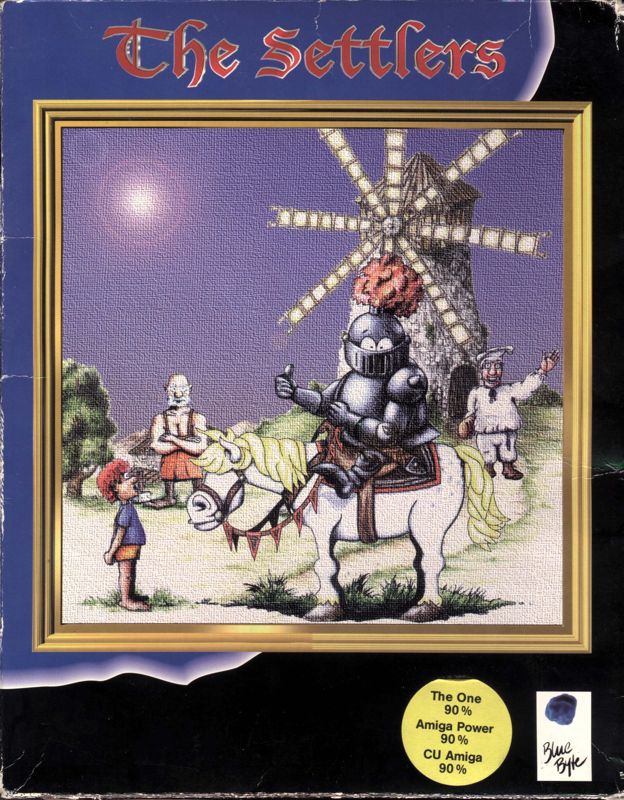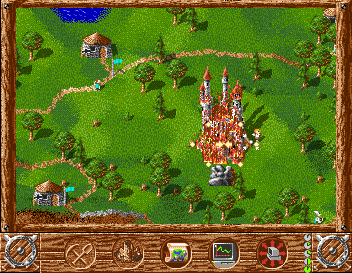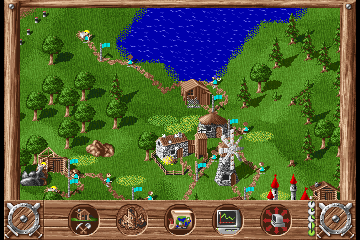Retro Replay Review
Gameplay
Serf City: Life is Feudal introduces a deeply engaging strategy loop centered on resource management and territorial expansion. At the outset of each level, you’re tasked with selecting the optimal landing zone, balancing the need for flat land with access to trees, stone, and water. This setup phase immediately immerses you in strategic decision-making: the flat land will host future farms and structures, while nearby resources will sustain your economy and war machine.
(HEY YOU!! We hope you enjoy! We try not to run ads. So basically, this is a very expensive hobby running this site. Please consider joining us for updates, forums, and more. Network w/ us to make some cash or friends while retro gaming, and you can win some free retro games for posting. Okay, carry on 👍)
The core of the gameplay revolves around constructing and upgrading a variety of buildings, each with its own resource requirements. Wood and stone are the building blocks, while specific operations—like milling grain, baking bread, fishing, or pig farming—call for a chain of interdependent structures. This interconnected system ensures that every decision, from harvesting wood to assigning a miner to extract coal, directly influences your ability to feed workers, build armies, and expand your hold on the map.
Territorial control is represented by huts and watch-towers, which not only extend your domain but can erode an enemy’s land when placed tactically. Clever players will identify key production buildings in the enemy camp and seize adjacent plots, crippling rival economies. When it’s time to press the advantage, combat is conducted in one-on-one skirmishes between your soldiers and your opponent’s troops, with the victor dealing a knockout punch to surrounding structures.
With 30 preset missions, including six tutorial scenarios designed to gradually introduce mechanics, Serf City delivers immediate challenges and a steep but rewarding learning curve. For those seeking endless variety, the semi-random map generator—driven by a 16-number key—creates fresh battlegrounds of varying sizes, from quick-match dashes to epic, 50-hour epics on large maps. Local split-screen play for two players adds a delightful layer of competitive camaraderie, provided both players bring a mouse to the table.
Graphics
Visually, Serf City embraces a charming, cartoony style that lends the game an innocent, lighthearted feel. Buildings are colorful and distinct, making it easy to identify structures at a glance. The cheerful aesthetic softens the competitive edge of the gameplay, ensuring that even when resources run low or rival armies advance on your walls, the experience remains approachable and fun.
Animations are simple but effective: trees sway, water ripples, and workers trot along to their tasks with a bouncy enthusiasm. While the game doesn’t push for photorealism, it excels at clarity—every resource node, pathway, and unit silhouette is instantly recognizable. This visual straightforwardness helps players stay focused on strategy rather than getting bogged down by overly detailed art.
Performance-wise, the game runs smoothly on modest hardware, though map size can influence memory usage. On larger maps, expect longer loading times and slightly slower frame rates, but nothing that breaks the gameplay loop. The UI is intuitive, with clear icons for resources and building options, ensuring that veteran strategists and newcomers alike can navigate menus without frustration.
Subtle touches, like celebratory confetti when you win a skirmish or the comedic fall of a defeated soldier, reinforce the game’s playful tone. Ambient sounds of chopping wood, flowing water, and distant battle shouts round out the audiovisual package, making Serf City a visually cohesive and enjoyable environment in which to wage your feudal conquests.
Story
Serf City doesn’t follow a traditional narrative arc; instead, it presents structured missions that guide you through escalating challenges. The six tutorial levels act as a prologue, teaching you the essentials of resource chains and combat tactics. After that, the 24 main missions introduce a variety of objectives—defend chokepoints, seize resource-rich areas, or eliminate multiple opponents in succession.
While there is no grand, character-driven storyline, each mission is framed by a brief premise that sets the stage: a desperate lord needs your help, local peasants are starving without sufficient food production, or a rival clan threatens to invade. These snippets of context give each map a sense of purpose, motivating you to string together efficient supply lines and build an army capable of toppling your foes.
The random map generator adds its own emergent storytelling. No two seeded runs are identical, and the shifting geography—from sprawling rivers to dense forests—creates fresh narratives about survival, diplomacy (temporarily cordial truces between human players), and cunning territory grabs. Each match evolves organically, forging memorable moments when either your tightly orchestrated economy or a last-minute sally with your troops turns the tide.
Though fans of deep, character-rich epics might miss a lore-driven plot, Serf City’s mission-based structure and open-ended skirmishes foster their own kind of narrative. Your legend is written through resource surpluses, castle expansions, and triumphant battles rather than dialogue trees or cinematic cutscenes.
Overall Experience
Serf City: Life is Feudal stands out as a treat for strategy enthusiasts who appreciate a delicate balance between resource micro-management and macro-scale conquest. The learning curve is inviting thanks to clear tutorials, yet the depth of its building chains, territorial tactics, and combat mechanics ensures that mastery requires dedication and experimentation. Every mismatch between food production and army size quickly becomes a valuable lesson in planning ahead.
Replayability is a core strength. Whether you’re grinding through preset missions to perfect your efficiency or diving into the randomness of generated maps, the game offers countless hours of strategic puzzling. Split-screen multiplayer adds a cozy couch-competitive dynamic, while the solo experience leans into thoughtful, methodical play. The variety in map sizes means you can squeeze in a quick match or settle in for an all-day siege.
While the absence of a traditional narrative and the playful graphics might put off those seeking epic medieval sagas, Serf City compensates with its brain-teasing resource chains and dynamic expansion tactics. The game’s wholesome humor—cartoonish skirmishes, cheering villagers, and jolly sound effects—creates an engaging atmosphere where every victory feels earned and every defeat teaches a lesson.
In the realm of feudal strategy titles, Serf City: Life is Feudal strikes a commendable balance between approachability and complexity. It’s a delightful invitation to hone your logistical prowess, outsmart rival lords, and build an ever-thriving domain from humble serf beginnings—all wrapped in a bright, jovial package that invites you back for “just one more match.”
 Retro Replay Retro Replay gaming reviews, news, emulation, geek stuff and more!
Retro Replay Retro Replay gaming reviews, news, emulation, geek stuff and more!









Reviews
There are no reviews yet.